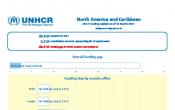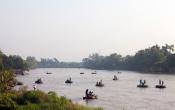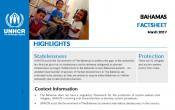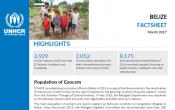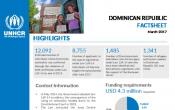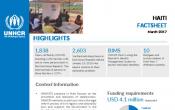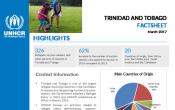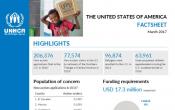United States of America Regional Office
The UNHCR’s Regional Office in Washington covers operations in the United States, 15 Caribbean states and 9 overseas territories including Antigua and Barbuda, the Bahamas, Barbados, Belize, Dominica, Dominican Republic, Grenada, Guyana, Haiti, Jamaica, St. Kitts and Nevis, St. Lucia, St. Vincent and the Grenadines, Suriname and Trinidad and Tobago; the British overseas territories of Anguilla, Bermuda, British Virgin Islands, Cayman Islands, Montserrat and Turks and Caicos Islands; and the Dutch overseas territories of the Kingdom of the Netherlands: Aruba, Curacao and Sint Maarten.
Operation: United States of America Regional Office
Location
{"longitude":-77,"latitude":20,"zoom_level":4}
Latest update of camps and office locations 21 Nov 2016. By clicking on the icons on the map, additional information is displayed.
Key Figures
| 2016 end-year results | |
| 500 | asylum and refugee officers were trained, representing, a 112 per cent increase from the previous year |
| 37 | refugees departed via resettlement from four countries in the region |
| 33 | cases (44 people) were submitted for resettlement to three different resettlement countries by the Regional Office |
| 2017 planning figures | |
| 85% | of all resettlement places will be allocated to submissions from UNHCR |
| 75% | of status determination procedures will meet the minimum procedural standards advocated by UNHCR |
| 16% | of stateless persons will be granted nationality or have their nationality confirmed |
People of Concern
18%
Increase in
2016
2016
| 2016 | 824,071 |
| 2015 | 696,796 |
| 2014 | 667,000 |

[["Refugees",273793],["Asylum-seekers",546258],["Stateless",2302],["Others of concern",1718]]
Loading ...
United States of America Regional Office
< Back
2016
{"categories":[2012,2013,2014,2015,2016,2017],"budget":[20.01324517,18.89196675,18.37469792,20.2999998,22.29719746,27.663202],"expenditure":[13.0322247,10.30046598,9.58497656,7.86237461,11.10863967,null]}
{"categories":[2012,2013,2014,2015,2016,2017],"p1":[7.3167857,6.10626973,7.70721431,11.32899624,13.63039142,15.49888192],"p2":[9.49280496,8.85035402,7.39718888,8.97100356,8.66680604,12.16432008],"p3":[null,null,null,null,null,null],"p4":[3.20365451,3.935343,3.27029473,null,null,null]}
{"categories":[2012,2013,2014,2015,2016,2017],"p1":[4.9216835,5.03311855,5.43034147,4.95750044,7.61021868,null],"p2":[6.11867346,4.17918809,3.53406058,2.90487417,3.49842099,null],"p3":[null,null,null,null,null,null],"p4":[1.99186774,1.08815934,0.62057451,null,null,null]}
Loading ...
CHOOSE A YEAR
- 2016
- 2017
Working environment
In the United States, increasing pressure on the asylum system was witnessed throughout 2016 due to the growing number of asylum-seekers from the Northern Triangle of Central America (NTCA) and Venezuela. The administration has introduced measures to address the current influx particularly when it comes to strengthening reception systems for children and families.Much of the Caribbean region continues to lack systematic protection-sensitive entry and referral mechanisms and safeguards to prevent refoulement.
The Northern America subregion is also confronted with a large stateless population and its associated protection needs.
Population trends
- The Unites States received more than 186,000 asylum applications in 2016, a 37 per cent increase from the previous year.
- In the Caribbean, UNHCR and its partners registered over 5,000 asylum-seekers in 2016, an increase of more than 50 per cent compared to 2015.
Achievements and impact
- The refugee flow from the NTCA continued to increase and dominated UNHCR’s advocacy agenda.
- UNHCR together with the Migration Policy Institute launched and led a protection dialogue process to examine the challenges confronting the national asylum system and resulted in a set of recommendations for the new Administration.
- In the Caribbean, the implementation of the Protection and Solutions Strategy led to the first technical meeting of the Caribbean Migration Consultations in December 2016, with the participation of 20 countries.
Unmet needs
- Limited resettlement places for refugees arriving in the Caribbean region in addition to limited opportunities for local integration and voluntary repatriation.
- Limited protection capacity on the ground in the Caribbean to preserve and enhance protection space.
- Access to legal counselling in the US remains a serious gap for the majority of the asylum-seeking population.

